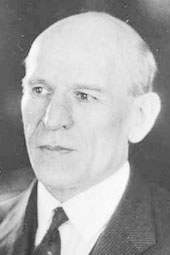
John Murray Atwood (September 25, 1869-November 4, 1951), a Universalist minister, educator, and denominational leader, served, for 37 years, as dean of the Canton Theological School of St. Lawrence University.
John (called Murray by his family) was born in a part of Brockton that is now in Bridgewater, Massachusetts. He was the fourth child, and only son, of Almira Church and Isaac Morgan Atwood. Ten years later, when his father became president of the Canton Theological School, the Atwoods moved to Canton, New York. Deeply connected to Canton and St. Lawrence University throughout his life, John graduated from Canton Academy, 1885, and earned three degrees from the St. Lawrence University: B.A.,1889; B.D., 1893; and M.A., 1900. He was awarded an honorary D.D. by Lombard University in 1906. As an undergraduate, he specialized in classics and distinguished himself academically, being elected to Phi Beta Kappa, and was a member of the varsity baseball team. Later, as a theological student, he coached the baseball team.
After taking his undergraduate degree, he spent a year, 1889-90, as a reporter for the Rocky Mountain News in Denver, before returning to Canton to enroll in the theological school. He became active there in the recently established Young Peoples’ Christian Union. Like his father, he was ordained at the Clifton Springs, New York church. He was minister there, 1893-95. In 1894 he married Addie B. Ford, whom he had first met while a theological student, and at whose church in Middleville, New York, near Utica, he often preached. They had three children: Ruth, Helen, and John.
Atwood next served The Third Universalist Church in Minneapolis, Minnesota, 1895-98. During 1898-99, he returned to Canton to teach ethics and logic at the theological school and to finish his Master’s degee. During a settlement in Portland, Maine, 1899-1905, he ministered as well to the students in nearby Westbrook Seminary, a coeducational school which had been founded by Universalists in 1834.
In 1905 Atwood returned to Canton to teach at St. Lawrence University. He remained there for the rest of his life. Initially he taught sociology and ethics in the theological school and Greek in the College of Letters and Science. Subsequently he taught most of the courses offered by the theological school and taught education, psychology, and philosophy in the college. Over the years he came to be regarded as a master teacher, drawing his students into discussions and seldom lecturing. The purpose of education, he said, “is not to make the youth the preconceived kind of being we may want him to be, but to help him fulfill the promise of his own inherent powers. The great object of education is to assist the individual to be what is in him to be.”
Atwood was himself a theist, seeing God as the force of living, active, human love, manifest in those who labor with “good will and sacrificial spirit for the good of their brothers.” Open to those with other theological orientations, he often defended colleagues who came under fire for their views, among them the pacifist Herbert Philbrook Morrell, Professor of Christian Ethics at the theological school, and Kenneth Patton, minister at the experimental Charles Street Meeting House in Boston, whom he invited to Canton to talk with his seminarians.
After serving a year as Gaines Professor of Philosophy, in 1914, on the death of Henry Prentiss Forbes, Atwood was named dean of the theological school. The years of his deanship, 1914-51, spanned two world wars, the Great Depression, a sharp denominational decline, and increasing competition for Universalist seminarians from theological schools other than those at St. Lawrence or Tufts. Among the graduates in Atwood’s time were Emerson Hugh Lalone, who became editor of the Universalist Leader; Gustav Ulrich, who worked with refugees in Europe following the Second World War; Max Kapp, who joined the faculty in 1942 and became the school’s last dean in 1960; Jeffrey Campbell, the school’s first African American graduate and a leading civil rights activist; Brainard Gibbons, who became president of the Universalist Church of America and then general superintendent; and Gene Navias, who became a denominational leader in religious education. An important addition to the faculty was Angus H. MacLean, a leading religious educator, who followed Atwood as the school’s dean.
Atwood took an active part in denominational affairs. He was on the board of trustees of the Canton Universalist church and taught in its church school. He served two terms as president of the Universalist General Convention, 1923-25 and 1925-27. Unlike his father, he had no interest in writing for publication.
Death
In 1949 Atwood suffered a heart attack but was able to continue teaching. In 1951, after a second heart attack, he resigned from the deanship, but as Dean Emeritus continued to meet his classes, often in his home. He died a month later while eating breakfast with his wife Addie and their daughter, Helen Harwood.
A few weeks later, the theological school’s Fisher Hall was destroyed by fire. In 1955 Addie Atwood participated in the laying of the cornerstone for a new building. The following year Atwood Hall was formally opened and dedicated as a memorial to Isaac Morgan Atwood and John Murray Atwood.
Sources
There is a chapter on John Murray Atwood in Clinton Lee Scott, These Live Tomorrow (1964) and short entries on him in David Robinson, The Unitarians and the Universalists (1985) and in Mark Harris, Historical Dictionary of Unitarian Universalism (2004). See also Russell Miller, The Larger Hope, volume 2 (1985) and Max Kapp and David Parke, 120 Years: An Account of the Theological School of St. Lawrence University, 1856-1976 (1976). The photo of Atwood is courtesy of the Unitarian Universalist Association.
Article by Charles A. Howe
Posted March 17, 2007